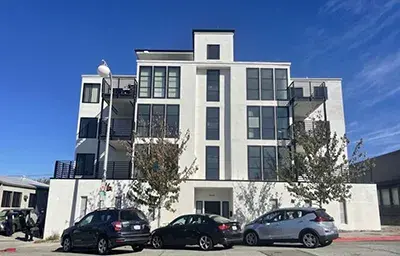For renters, the discovery that their home has been sold to new owners can bring a sense of dread and uncertainty. Will my rent be raised significantly? Will my family be evicted? Where can I find another affordable home in this community?
In response, housing advocates are increasingly calling for policies and programs that can help transition properties to tenant or community ownership at the initiation of a sale. Opportunity to Purchase Acts (OPAs) – one of these policy innovations – require property owners to give their tenants and/or community groups a Notice of Intent to Sell and provide them a first chance to make a purchase offer.
Variations of these policies include Tenant Opportunity to Purchase Acts (TOPAs) or Community Opportunity to Purchase Acts (COPAs), the latter being for mission-driven housing organizations. Either can allow groups the chance to match any final offer made by another party. Some communities across California – including Berkeley and Los Angeles County – have launched community campaigns to pass OPA policies, following San Francisco’s passage of a COPA In 2019.
|
Image

|
Solano Avenue Co-op Apartments (1685 Solano) in North Berkeley is the first affordable housing project in this high-resource neighborhood. This 13-unit building was preserved as permanently affordable housing for low-income households after the residents organized together and sought out resources to keep their homes after receiving Ellis Act Eviction notices from the building’s owners. The Bay Area Community Land Trust (BACLT) purchased the building in June 2022 after extensive negotiation and funding from the City’s Small Sites Program ($3.9 million) and Enterprise Community Loan Fund ($3.2 million). |
Are Opportunity to Purchase Acts Effective?
OPAs can be a catalytic piece of an overall affordable housing preservation strategy. Preservation, sometimes known as acquisition/rehabilitation, occurs when mission-driven buyers or tenants purchase unsubsidized, market-rate buildings and then rehabilitate and preserve them as affordable for the long term.
Preservation is a proven approach to ensuring the affordability of housing where lower-income households are already living, particularly in high-cost areas where households could be at heightened risk of displacement. This technique faces several challenges throughout the various phases from acquisition to rehabilitation to long-term stewardship. Three specific challenges typically occur early in the process:
- Tenants/mission-driven buyers lack information: Prospective tenant and nonprofit buyers may not know that the property might soon be available for sale since many properties of five or more units are bought and sold via brokerages and are never publicly listed.
- Insufficient time to organize and respond to a sale: Prospective tenant and nonprofit buyers need more time than typical investors to close on a sale. Tenants often need weeks to create tenant associations so they can organize purchases, while nonprofit organizations need time to assemble structured financing from multiple private and public sources.
- Insufficient and slow funding: Most jurisdictions currently do not have dedicated funding for affordable housing preservation, and state and federal resources are also insufficient.
OPAs address the first two challenges by requiring property owners to provide a notice of intent to sell and a right of first offer and/or refusal, which levels the playing field between investor-buyers and community-based buyers. Washington, D.C., adopted the first TOPA policy in the country in 1980, and since 2006 alone, the policy has been used by tenants and nonprofits to purchase 19,000 homes, over 16,000 of which are affordable. Additionally, TOPA in D.C. has enabled the creation of approximately 4,400 homes within limited equity housing cooperatives, entities that provide ownership pathways for lower-income households for whom traditional homeownership is often out of reach.
OPA Policy Design Makes All the Difference
As more jurisdictions weigh whether to pursue OPAs of their own, it is important to consider how key policy elements can be customized to reflect existing conditions in each area.
Types of Properties
OPA policies should be designed with the building stock of each respective city in mind so that the greatest number of households at risk of displacement can use them. For example, one sticking point in many OPA debates centers on whether single-family homes should be covered under the policies. There are concerns – often without evidence – that applying OPA policies to single-family homes can cause delays in property owners’ sale timelines. However, most single-family home sellers spend months or even up to a year preparing for a sale, so property owners can easily provide notice to nonprofit buyers and tenants at the same time as they handle other necessary pre-listing activities.
Types of Buyers
In designing OPAs, jurisdictions must weigh whether nonprofits, tenants, public agencies, or some combination of the three should be eligible to receive the right of first offer and/or refusal. Tenant purchases lead to direct tenant ownership and equity-building opportunities, while mission-driven housing organizations sometimes provide equity-building opportunities through community land trusts (CLT) or limited equity housing cooperative models but may only offer rental opportunities to tenants.
Debates therefore often center on whether organizations should also be able to serve as intermediary buyers, since ownership may be a strong policy priority. However, mission-driven housing organizations are critical in high-cost areas where the median home price tends to be far out of reach for lower-income renter families. Nonprofit buyers can assemble private and public debt and private donations to purchase properties and convert them to affordable housing. For this reason, campaigns in cities like Berkeley provide rights to both tenants and nonprofit organizations.
Mission-driven housing organizations are especially helpful when it comes to preserving multifamily buildings, which become increasingly complex to purchase as the size of the building and the number of renter families involved increases. To execute a direct tenant purchase, most of the renters in these buildings would need to agree to the property ownership transition plan and must have access to tenant-supportive intermediaries including consultants and pro bono technical assistance providers to assemble financing and negotiate legal agreements.
Washington, D.C., funds such technical assistance providers, and tenants rely on them with strong results. Jurisdictions should weigh their own organizational capacity when determining whether mission-driven housing organizations, tenants, or both should receive OPA rights.
Time Needed to Complete Transactions
Some jurisdictions have proposed policies with shorter timelines to reduce perceived or actual impacts on the housing market. However, the impact of OPA policies hinges on having realistic time frames for tenants or nonprofits to express interest in purchasing a property, contact tenants, conduct due diligence, make an offer, and close the sale.
For example, in San Francisco, nonprofit organizations only have five days to determine whether they are interested in purchasing a property through COPA, which has limited the policy’s effectiveness. In contrast, Washington, D.C., which has had a TOPA in effect since 1980, provides tenants with 45 days to express initial interest in purchasing their property. Even though the policy was adopted during a period of severe urban disinvestment, having a TOPA in effect has not prevented this real estate market from evolving into one of the highest-cost residential markets in the country.
Maximize the Effectiveness of OPA Policies in California
In addition to key policy design questions, several elements of an affordable housing preservation ecosystem need to be in place for OPA policies to be effective. Perhaps the most important is funding for affordable housing preservation. As with all affordable housing creation in high-cost markets, subsidies are critical to ensuring that OPAs have an impact at scale on affordable housing preservation – which is significantly less expensive on a per-unit basis than new affordable housing construction.
Fortunately, at least one new preservation funding source should soon be available in California for 1- to 25-unit properties in foreclosure or at risk of foreclosure via the Foreclosure Intervention Housing Preservation Program (FIHPP). Multiple new preservation funding sources have also been proposed in our state and merit the support of community members and elected officials, such as the Community Anti-Displacement and Preservation Program. Another game-changer for preservation would come to the Bay Area if the $10-20 billion regional housing measure for the Bay Area Housing Finance Authority (BAHFA) is approved by voters in November 2024.
The Need for Organizational Capacity
Organizational capacity to engage in preservation is another critical factor for OPA success. Washington, D.C., provides a successful example of how jurisdictions can provide support to establish and maintain the tenant-supportive organizations that tenants rely on to establish tenant associations.
In jurisdictions that plan to provide a right of first offer to emerging mission-driven housing organizations, the capacity of these organizations to durably carry out preservation work and take advantage of OPAs is also a key concern. Fortunately, both the public and philanthropic sectors are establishing capacity-building programs to support emerging qualified nonprofits and capacity is growing in many regions. For example, FIHPP will be accompanied by a three-year technical assistance program for mission-driven housing organizations that Enterprise will administer.
Finally, jurisdictions should consider their timing when considering OPA policies. Affordable housing preservation can be easier in relatively low-cost areas where acquisition prices are still relatively affordable. OPAs can therefore be especially useful in places like the Central Valley in California, where homeownership continues to be more financially accessible for renter families relative to urban metro areas.
And even in higher-cost areas, adopting OPA policies before major preservation funding sources come online can be a strategic move. For example, passing OPAs before the Bay Area’s prospective affordable housing bond measure would better position mission-driven affordable housing providers to immediately leverage new funds if the measure passes.
The City of Berkeley and Los Angeles County are jurisdictions with proposed TOPA policies where these elements are all in place: These jurisdictions regularly put out local funds for affordable housing preservation, with significantly more state (and in the case of Berkeley, regional) funding on the horizon, and multiple high-capacity mission-driven housing providers are already active in the area. To find out more, get in touch with Urban Habitat and read about campaigns in Berkeley and Los Angeles.
OPAs have enabled thousands of tenants and nonprofit property purchases that otherwise would have been highly unlikely to occur in Washington, D.C., and in doing so likely preventing escalating housing cost burdens or the displacement of renter families. With the emergence of several opportunities to pass similar policies in other jurisdictions, thousands more renter families in other high-cost areas here in California could have another tool in the toolkit for maintaining their housing stability.

